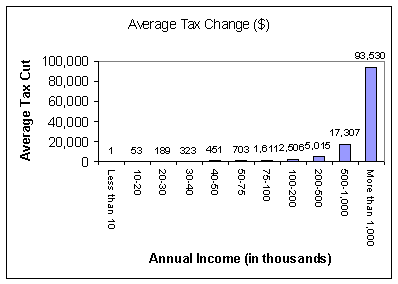
Tax Priorities
by Guest Blogger, 6/2/2003
The 2003 tax cut package contained a number of goodies for higher income individuals -- a dividend tax cut, a capital gains tax cut, acceleration of previous reductions in upper income tax rates. However, several reports have shown that millions of taxpayers, primarily middle income and below, as well as millions of children, have been left behind.
The 2003 tax cut package contained a number of goodies for higher income individuals -- a dividend tax cut, a capital gains tax cut, acceleration of previous reductions in upper income tax rates. However, several reports have shown that millions of taxpayers, primarily middle income and below, as well as millions of children, have been left behind.
Last Thursday, the New York Times and every major evening news program reported that a key provision that would have helped low income families was left out of the final tax law as signed by the President. At the last minute, Republican leaders and administration officials were trying to find ways to reduce the total cost of the tax bill – one of the provisions that was left out was one that would change the formula for determining who would receive the per-child tax credit.
The number of people left out due to this omission was computed in a study by the Center on Budget and Policy Priorities (CBPP), which found that those families earning between $10,500 to $26,625 would not benefit from the increase in the increased per-child tax credit. The omission means that families representing 11.9 million children were left behind by the tax bill.
More recently, another CBPP analysis based on data from the Urban Institute-Brookings Institution Tax Policy Center, found that there are over 8 million income-tax payers that will not receive a benefit from the tax cut. These taxpayers include:
- 5 million single taxpayers in the 10 percent tax bracket who have no children and receive no dividend or capital gains income
- 2.6 million taxpayers with “head-of-household” filing status with dependents over 16 years old and in the 10 or 15% tax bracket
Over 80% of these tax filers left behind earn less than $30,000 per year.
Today’s Washington Post casts a more cynical view about this omission. The Post notes that the President’s proposal, the House bill, and the original Senate Finance Committee proposal did not contain the child tax credit for lower income families.
In addition, there are millions more people who pay taxes (in the form of payroll taxes, sales taxes, etc.) that would receive no benefit from the President’s targeted federal income tax cut.
An analysis by The Tax Policy Center also shows just how much more upper income individuals will benefit from the tax cut. People earning more that $1 million will receive a tax cut of over $90,000, while those in the middle of the income distribution will receive only $200. (See chart below.)
Finally, the tax bill will balloon the deficit. If the tax cuts are allowed to expire, the tax bill will tack on “only” $350 billion. If, however, these provisions are extended, the total cost will likely be somewhere between $800 billion and $1 trillion. This debt increase will simply be passed on to future generations who will have to face greater taxes, or fewer government benefits, down the road.
In a time of budgetary and economic weakness it is more important than ever to use sound and fair judgment on matters of tax policy and issues of basic fairness. The current actions of the White House and the Republican leadership show that the priorities of many in Washington do not include a significant portion of the US population, and are out of step with what most people would think is fair.



